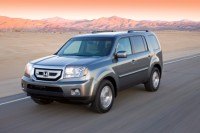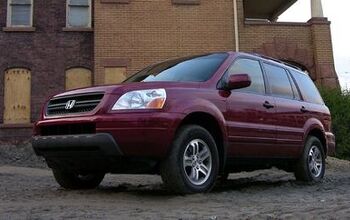2009 Honda Pilot EX-L Review, Take 2
Growing up, I thought the Porsche 911 was hideous. Its bug eyes and lumpy lines made me wonder if the designer had accidentally knocked modeling clay off his drafting table and submitted the splatter. This notion persisted until I drove one. Some 130 mph later, I considered the 911 the most beautiful automotive form on earth. Driving the all-new 2009 Honda Pilot EX-L kinda sorta triggered the same type of perceptual realignment. Call it Zen and the art of "challenging" design.
That's not to say I hated the new Pilot's looks at first glance. The effete minivan-ish look of the first generation CUV needed beefing-up more than an anorexic body-builder. So I was ready for something radical. And boy, did I get it. The new Pilot's grill "features" a thick chrome double-D rotated 90-degrees to the right; an affectation that's more Tranformers than transformative. The Pilot's rear end demonstrates the classic SUV refrigerator-on-wheels look, easily confused with the new Liberty (sans trapezoidal wheel wells). Taken as a whole, the new Pilot is like the big-boned girl that people can't decide whether she's an ugly duckling or the next "it" girl (I'm looking at you Scarlet Johansson).
The Pilot might not have turned out exactly as Honda's chief designer Dave Marek intended, but the look certainly projects greater solidity and presence than it's predecessor. Stylistically, the new Pilot harks back to a simpler time, when real men (and their wives) drove SUVs [kidding-ish]. If you think that the new Toyota Highlander looks like a contemporary example of Japanese design running awry of American taste, and that futuristic CUV's such as the Ford Edge and Mazda CX-9 look more at home on the cover of a Journey album than rolling around U.S. highways, they you'll find Pilot's masculine simplicity a step in the right direction. If not, not.
The Pilot's inner confines are free from the pseudo-luxury pretenses that afflict nearly every other car on the road. Aside from the cowhide pulled tight over seats and steering wheel, all surfaces are fashioned from easy-to-clean durable plastic. These are not brittle poor-quality polymers masquerading as chrome or wood, but proud durable materials that know that their primary role is to serve families with messy kids.
The Pilot's front seats are comfortable and supportive enough for non-track trekking. The second and third rows are little more than padded benches that fold flat. Kids are cool, but the Geneva Convention specifically prohibits adults from extended tours of duty. Parents that don't pony-up for the Touring Edition with satellite navigation still avoid smushed tikes and trikes via the Pilot's rearview backup camera, with a display conveniently located in the rear view mirror.
When I tested a Gen One Pilot about two months ago, I was shocked by how poorly it drove and handled. The crossover that once set the standard for SUV-driving dynamics had been thoroughly outclassed by the rest of the industry. Especially notable: the four-wheel independent suspension-equipped, front wheel-drive (FWD) trucklet's tendency to crab-walk its way over bumps.
The '09 Pilot's handling dynamics now boast contemporary car-like excellence. Soccer moms and suburban dads can now schlep kids to school, fetch groceries and commute to work without wrestling with the tiller. The base Pilot's tendency to torque steer, introduced when Honda deleted all wheel-drive (in pursuit of mpg), hasn't been eliminated. But drivers are now unlikely to push the engine above 4800 rpm, where the twist wreaked havoc with the FWD model's steering. By 5500 rpm, the power steering boosts to counteract the torque, and all steering feedback blacks out.
As you'd expect, Honda told their engineers to preserve the Pilot's performance while squeezing more fuel economy from the package. The '09 Pilot is powered by a new 3.5-Liter 24-Valve SOHC i-VTEC V-6 engine that's good for an adequate (i.e. faint praise) 250hp and 253 lb-ft torque. The minor power increase offsets the new truck's extra 84 lbs. (about two percent more), keeping the horsepower-to-weight ratio nearly identical to the outgoing model. In real world driving, anyone familiar with the old Pilots won't discern any difference.
The powerplant features Honda's improved Variable Cylinder Management system (previously only available on the FWD Pilots). While the resulting 17/22 mpg might make Civic drivers cringe, according to the fine folks at the EPA the system delivers up to seven percent better fuel economy in town and 10 percent on the highway. At the least the bump removes a psychological barrier for re-upping Pilots.
The Honda Pilot may not have hardcore towing or off-road ‘wheeling machine skills, but it can do both in a limited capacity. It's best to simply think of the Pilot as a slightly larger eight-passenger version of Honda's excellent CR-V. Rock solid. Safe. Unpretentious. Practical. Reliable. Zen for families that appreciate the finer points of basic transportation.
More by William C Montgomery
Latest Car Reviews
Read moreLatest Product Reviews
Read moreRecent Comments
- Redapple2 Love the wheels
- Redapple2 Good luck to them. They used to make great cars. 510. 240Z, Sentra SE-R. Maxima. Frontier.
- Joe65688619 Under Ghosn they went through the same short-term bottom-line thinking that GM did in the 80s/90s, and they have not recovered say, to their heyday in the 50s and 60s in terms of market share and innovation. Poor design decisions (a CVT in their front-wheel drive "4-Door Sports Car", model overlap in a poorly performing segment (they never needed the Altima AND the Maxima...what they needed was one vehicle with different drivetrain, including hybrid, to compete with the Accord/Camry, and decontenting their vehicles: My 2012 QX56 (I know, not a Nissan, but the same holds for the Armada) had power rear windows in the cargo area that could vent, a glass hatch on the back door that could be opened separate from the whole liftgate (in such a tall vehicle, kinda essential if you have it in a garage and want to load the trunk without having to open the garage door to make room for the lift gate), a nice driver's side folding armrest, and a few other quality-of-life details absent from my 2018 QX80. In a competitive market this attention to detai is can be the differentiator that sell cars. Now they are caught in the middle of the market, competing more with Hyundai and Kia and selling discounted vehicles near the same price points, but losing money on them. They invested also invested a lot in niche platforms. The Leaf was one of the first full EVs, but never really evolved. They misjudged the market - luxury EVs are selling, small budget models not so much. Variable compression engines offering little in terms of real-world power or tech, let a lot of complexity that is leading to higher failure rates. Aside from the Z and GT-R (low volume models), not much forced induction (whether your a fan or not, look at what Honda did with the CR-V and Acura RDX - same chassis, slap a turbo on it, make it nicer inside, and now you can sell it as a semi-premium brand with higher markup). That said, I do believe they retain the technical and engineering capability to do far better. About time management realized they need to make smarter investments and understand their markets better.
- Kwik_Shift_Pro4X Off-road fluff on vehicles that should not be off road needs to die.
- Kwik_Shift_Pro4X Saw this posted on social media; “Just bought a 2023 Tundra with the 14" screen. Let my son borrow it for the afternoon, he connected his phone to listen to his iTunes.The next day my insurance company raised my rates and added my son to my policy. The email said that a private company showed that my son drove the vehicle. He already had his own vehicle that he was insuring.My insurance company demanded he give all his insurance info and some private info for proof. He declined for privacy reasons and my insurance cancelled my policy.These new vehicles with their tech are on condition that we give up our privacy to enter their world. It's not worth it people.”






































Comments
Join the conversation
I have a 2007 Honda Pilot and would like to trade it in for something newer. Based on the 2007, I don't think that I would consider another Pilot. While I know that Hondas are reliable and I have had no problems with it, I am very dissapointed in how noisy it is. The road noise on the highway is awful. The air-conditioner sounds like a jet engine and you cannot carry on a conversation while its running. I hate the air vents on the console - there's no way to close the middle ones, only the side ones. The display on the radio/clock is impossible to see when wearing sun glasses.
I own a 2009 Honda Pilot (automatic transmission) from Repokar car auction. The 1.8 Liter engine is the center piece of this car. While cruising on the highway, the engine is composed and fuel efficient. So, it is literally a two-faced engine that can be both fun or economical. The transmission will stay smooth as long as you change the fluid on schedule (every 30k miles)But in rest it is very well performed and I like driving it)))